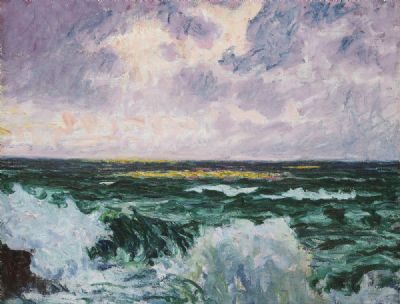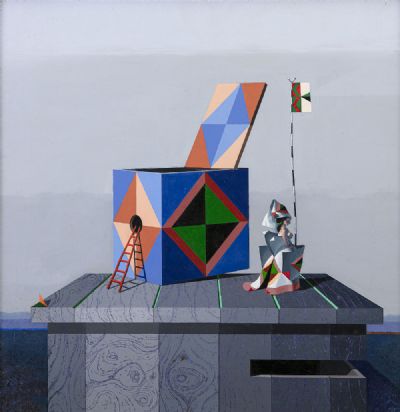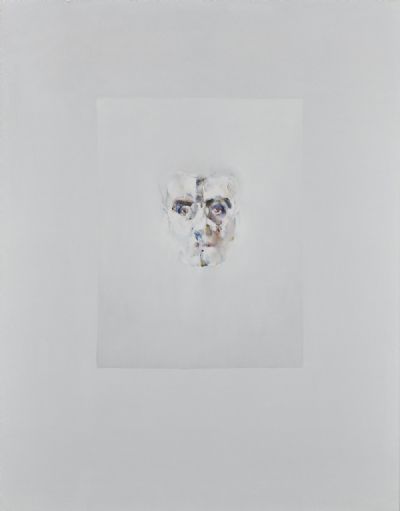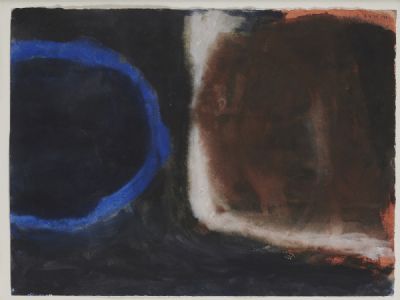Bidding on this item has ended.
Roderic O'Conor
SEA AND RED ROCKS
Lot 18
Price Realised:
€70,000
Estimate:
€50,000 - €70,000
Roderic O'Conor, 1860-1940
SEA AND RED ROCKS, c.1898
Oil on panel, 9.5" x 11" (24.2 x 28.1cm).
Provenance: Private collection.
Exhibited: Roland, Browse & Delbanco, London, Christmas Present Exhibition, 27 November to 24 December 1964,...
Read more
 Lot 18
Roderic O'Conor
SEA AND RED ROCKS
Lot 18
Roderic O'Conor
SEA AND RED ROCKS
 Lot 18
Roderic O'Conor
SEA AND RED ROCKS
Lot 18
Roderic O'Conor
SEA AND RED ROCKS
Estimate:
€50,000 - €70,000
Roderic O'Conor, 1860-1940
SEA AND RED ROCKS, c.1898
Oil on panel, 9.5" x 11" (24.2 x 28.1cm).
Provenance: Private collection.
Exhibited: Roland, Browse & Delbanco, London, Christmas Present Exhibition, 27 November to 24 December 1964, no. 71.
This important Breton seascape by Roderic O'Conor came to light only recently after being part of a private collection for nearly 60 years. It is one of a group of four seascapes executed on same-size wooden panels in the late 1890s, all of them characterised by energetic brushstrokes successfully replicating the movements of the waves, whilst deploying a vibrant palette that heightens the local colours found in nature.
In 1898 O'Conor's work took on renewed impetus with his displacement from Rochefort-en-terre, a village in the Breton interior, in favour of his former stamping grounds at Pont-Aven and Le Pouldu. His removal to the coast inspired him to embark on an extensive series of seascapes that took their cue from Gauguin's bold use of colour, albeit with a personal twist involving the juxtaposition of complementary blues and oranges, greens and reds, often extending over large areas of the picture surface. The terrain he frequented was famed not only for its wild seas but also for its distinctive pink granite and red sandstone rocks, some of them as high as 20 metres. In one sense the pictures enabled him to fulfil the quest for a primitive, unsullied corner of nature that Gauguin had advocated when they became friends in 1894. On a more practical level, the turbulent waves and craggy foreshore of Finistère (literally 'End of the Earth') gave the Irishman full scope to harness his expressive painting technique to a subject comprising the relentless clash of elemental forces.
In preparation for the series O'Conor toured some of Brittany's most remote stretches of wild rocky coastline. For example in 1899 he spent several months next to a lighthouse at St. Guenole in the far west of the province, before moving on in July to the Breton island of Belle-Ile, well known for its huge sea caves and "waves creaming and foaming over the green rocks ... Nature at her biggest and best" (Dorothy Menpes, Brittany, 1905). O'Conor was no doubt aware of Claude Monet's visit to Belle-Ile in the autumn of 1886 when he captured the dramatic scenery and fierce storms in a series of seascapes. Monet's paintings were essentially Impressionist in style, whereas O'Conor opted for a more modernist interpretation that prefigures the dazzling colours unleashed by Matisse, Derain and the other Fauve painters in 1904-05, much to the consternation of the critics.
Sea and Red Rocks is related to a larger work, Red rocks, Brittany, in which the foreshore dominates the sea thanks to the artist's adoption of a more panoramic view (Benington 1992, no. 72, p. 198). By taking a more focused and close-up approach in the smaller work, O'Conor effects a greater balance between land and sea, wielding a thicker brush to quickly evoke the structure of the granite, as if paying tribute to the molten origins of this igneous rock. The bright crimson with which he has chosen to paint the entire foreground of the composition is as bold a statement as one can find in late nineteenth-century European painting. Working with speed and confidence, O'Conor varied the weight and direction of his mark-making to match the motion of the waves breaking over the outlying rocks.
Jonathan Benington
SEA AND RED ROCKS, c.1898
Oil on panel, 9.5" x 11" (24.2 x 28.1cm).
Provenance: Private collection.
Exhibited: Roland, Browse & Delbanco, London, Christmas Present Exhibition, 27 November to 24 December 1964, no. 71.
This important Breton seascape by Roderic O'Conor came to light only recently after being part of a private collection for nearly 60 years. It is one of a group of four seascapes executed on same-size wooden panels in the late 1890s, all of them characterised by energetic brushstrokes successfully replicating the movements of the waves, whilst deploying a vibrant palette that heightens the local colours found in nature.
In 1898 O'Conor's work took on renewed impetus with his displacement from Rochefort-en-terre, a village in the Breton interior, in favour of his former stamping grounds at Pont-Aven and Le Pouldu. His removal to the coast inspired him to embark on an extensive series of seascapes that took their cue from Gauguin's bold use of colour, albeit with a personal twist involving the juxtaposition of complementary blues and oranges, greens and reds, often extending over large areas of the picture surface. The terrain he frequented was famed not only for its wild seas but also for its distinctive pink granite and red sandstone rocks, some of them as high as 20 metres. In one sense the pictures enabled him to fulfil the quest for a primitive, unsullied corner of nature that Gauguin had advocated when they became friends in 1894. On a more practical level, the turbulent waves and craggy foreshore of Finistère (literally 'End of the Earth') gave the Irishman full scope to harness his expressive painting technique to a subject comprising the relentless clash of elemental forces.
In preparation for the series O'Conor toured some of Brittany's most remote stretches of wild rocky coastline. For example in 1899 he spent several months next to a lighthouse at St. Guenole in the far west of the province, before moving on in July to the Breton island of Belle-Ile, well known for its huge sea caves and "waves creaming and foaming over the green rocks ... Nature at her biggest and best" (Dorothy Menpes, Brittany, 1905). O'Conor was no doubt aware of Claude Monet's visit to Belle-Ile in the autumn of 1886 when he captured the dramatic scenery and fierce storms in a series of seascapes. Monet's paintings were essentially Impressionist in style, whereas O'Conor opted for a more modernist interpretation that prefigures the dazzling colours unleashed by Matisse, Derain and the other Fauve painters in 1904-05, much to the consternation of the critics.
Sea and Red Rocks is related to a larger work, Red rocks, Brittany, in which the foreshore dominates the sea thanks to the artist's adoption of a more panoramic view (Benington 1992, no. 72, p. 198). By taking a more focused and close-up approach in the smaller work, O'Conor effects a greater balance between land and sea, wielding a thicker brush to quickly evoke the structure of the granite, as if paying tribute to the molten origins of this igneous rock. The bright crimson with which he has chosen to paint the entire foreground of the composition is as bold a statement as one can find in late nineteenth-century European painting. Working with speed and confidence, O'Conor varied the weight and direction of his mark-making to match the motion of the waves breaking over the outlying rocks.
Jonathan Benington
- Enquire
- View all lots by this artist
- How bidding works
Please note: You will require a deVeres account in order to bid. Please register via the website. Each lot will close numerically. If there is late bidding the time may be extended which could delay subsequent lots. The lots will start to close from 2.00pm on auction day, closing at 45 second intervals.
PLEASE BID EARLY TO AVOID DISAPPOINTMENT.
In order to allow rival bidders the opportunity to respond to a late bid the following extensions will apply:
IF A BID IS RECEIVED WITHIN THE FINAL 45 SECONDS OF THE COUNTDOWN THE CLOCK WILL RESET TO 60 SECONDS.
At any point you can leave a maximum bid, representing the highest price you are prepared to pay for a particular lot. Bidding only advances when there is competition from a rival bidder. In that case the system bids on your behalf, only up to the maximum if required. All bids are relayed to you be email, along with notification if you have been outbid.
All maximum bids are confidential and not disclosed. The system will endeavor to purchase the lot for you for the least price. Bids are subject to buyer’s premium of 25% (incl vat), with no additional charges.
In the event of a tied bid, the preference will be given to the bid submitted first. The second bidder will receive immediate notification of being outbid.
PLEASE BID EARLY TO AVOID DISAPPOINTMENT.
In order to allow rival bidders the opportunity to respond to a late bid the following extensions will apply:
IF A BID IS RECEIVED WITHIN THE FINAL 45 SECONDS OF THE COUNTDOWN THE CLOCK WILL RESET TO 60 SECONDS.
At any point you can leave a maximum bid, representing the highest price you are prepared to pay for a particular lot. Bidding only advances when there is competition from a rival bidder. In that case the system bids on your behalf, only up to the maximum if required. All bids are relayed to you be email, along with notification if you have been outbid.
All maximum bids are confidential and not disclosed. The system will endeavor to purchase the lot for you for the least price. Bids are subject to buyer’s premium of 25% (incl vat), with no additional charges.
In the event of a tied bid, the preference will be given to the bid submitted first. The second bidder will receive immediate notification of being outbid.
Sign-up to our auction alert
Signup for personalised Irish art recommendations, invitations to viewings and auctions, articles and more.

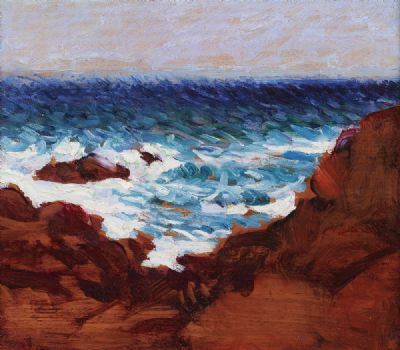
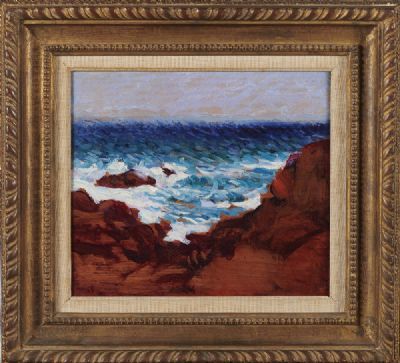
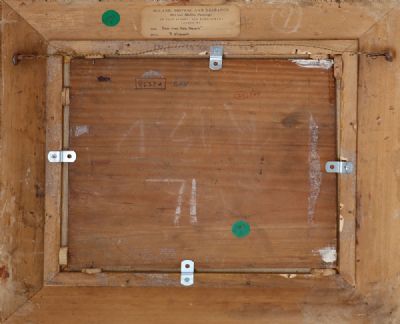
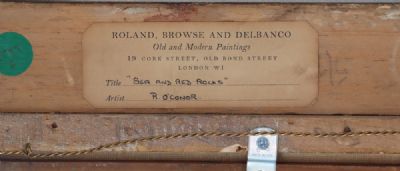
 View More Videos
View More Videos DVTV Click Here To View Video
DVTV Click Here To View Video